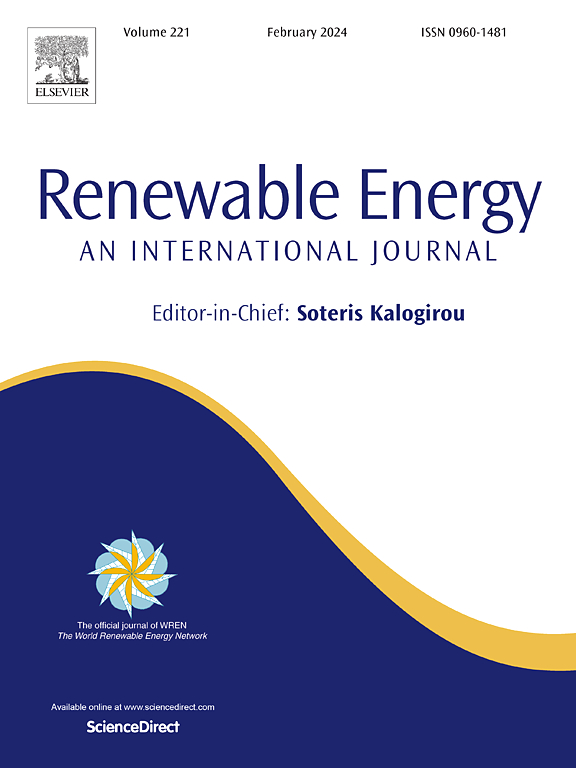Active load control applied to upscaled wind turbines: Design and cost impacts
IF 9
1区 工程技术
Q1 ENERGY & FUELS
引用次数: 0
Abstract
This study examines the combined effect of rotor upscaling and active load control (ALC), whereby ALC is used to offset the negative impacts of increased loads from an upscaled rotor that produces higher energy capture. Consequently, there is growing interest in innovative load control techniques to mitigate these excessive loads and their associated impacts on increased cost. In this study, ALC is implemented using controllable gurney flaps based on plasma actuators where we assess the impacts of upscaling and ALC on 1) loads of all major turbine components, 2) sizing of turbine components, 3) cost of energy including capital expenditures (CapEx), operating expenditures (OpEx), annual energy production (AEP), and ultimately the levelized cost of energy (LCOE). Additionally, ALC effects are examined for Region III-only operation and full-range, i.e., Region II and Region III. Upscaling is examined via two distinct scenarios: a power-uprated turbine design with a 6.3 % upscaled rotor and higher power rating (and higher structural loads), and a load-limited turbine design with the same increase in rotor size but maintaining the reference turbine power rating (to maintain or limit the load increase). Using a 3.4 MW reference wind turbine design, we maintain baseline performance limits with respect to the reference design for the tip deflection, mean stresses, and fatigue stresses in the upscaled design with ALC during the component resizing process. This resizing approach led to changes in CapEx, OpEx, AEP, and LCOE. Among the upscaled designs, the load-limited turbine with ALC achieved a slightly higher LCOE reduction of up to 4.9 % compared to 4.1 % for the power-uprated turbine, under full-range ALC operation. Overall, the load-limited upscaled design with ALC emerges as the marginally more favorable configuration, achieving greater LCOE reduction through a substantial AEP increase in Region II (due to upscaling), fatigue load reductions in critical components (via ALC), and relatively smaller capital cost increases compared to the power-uprated design, despite the latter yielding similar LCOE reductions. As a result, this work presents a comprehensive assessment of how ALC impacts component sizing and economics and compares upscaled designs (3.4B) with the 3.4A (retrofit) design, providing insights to designers and operators to most effectively use ALC in upscaled wind turbines.
应用于大型风力涡轮机的主动负荷控制:设计和成本影响
本研究考察了转子升级和主动负载控制(ALC)的综合效应,即ALC用于抵消从产生更高能量捕获的升级转子增加负载的负面影响。因此,人们对创新的负载控制技术越来越感兴趣,以减轻这些过度负载及其对增加成本的相关影响。在本研究中,ALC是使用基于等离子体致动器的可控轮床襟翼实现的,我们评估了升级和ALC对以下方面的影响:1)所有主要涡轮机部件的负载,2)涡轮机部件的尺寸,3)能源成本,包括资本支出(CapEx)、运营支出(OpEx)、年度能源生产(AEP),以及最终的能源平平成本(LCOE)。此外,还研究了仅III区操作和全范围(即II区和III区)的ALC效应。通过两种不同的场景来检查升级:功率升级的涡轮设计,转子尺寸升级6.3%,额定功率更高(以及更高的结构负载),以及负载限制的涡轮设计,转子尺寸增加相同,但保持参考涡轮额定功率(以保持或限制负载增加)。使用3.4 MW参考风力涡轮机设计,在组件调整过程中,我们在带有ALC的升级设计中保持了与参考设计有关的尖端偏转、平均应力和疲劳应力的基线性能限制。这种调整方法导致了CapEx、OpEx、AEP和LCOE的变化。在升级设计中,与全范围ALC运行的功率升级涡轮机相比,带有ALC的负载限制涡轮机的LCOE降低幅度略高,高达4.9%,而功率升级涡轮机的LCOE降低幅度为4.1%。总的来说,带ALC的负载限制升级设计是一种略微有利的配置,通过II区AEP的大幅增加(由于升级)实现了更大的LCOE降低,关键部件的疲劳负荷减少(通过ALC),与功率升级设计相比,资本成本的增加相对较小,尽管后者也产生了类似的LCOE降低。因此,本研究全面评估了ALC对组件尺寸和经济性的影响,并比较了升级设计(3.4B)和3.4A(改造)设计,为设计师和运营商在升级风力涡轮机中最有效地使用ALC提供了见解。
本文章由计算机程序翻译,如有差异,请以英文原文为准。
求助全文
约1分钟内获得全文
求助全文
来源期刊

Renewable Energy
工程技术-能源与燃料
CiteScore
18.40
自引率
9.20%
发文量
1955
审稿时长
6.6 months
期刊介绍:
Renewable Energy journal is dedicated to advancing knowledge and disseminating insights on various topics and technologies within renewable energy systems and components. Our mission is to support researchers, engineers, economists, manufacturers, NGOs, associations, and societies in staying updated on new developments in their respective fields and applying alternative energy solutions to current practices.
As an international, multidisciplinary journal in renewable energy engineering and research, we strive to be a premier peer-reviewed platform and a trusted source of original research and reviews in the field of renewable energy. Join us in our endeavor to drive innovation and progress in sustainable energy solutions.
 求助内容:
求助内容: 应助结果提醒方式:
应助结果提醒方式:


